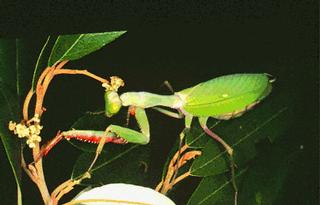 |
Order
- MANTODEA
(Greek, mantis = seer, prophet)
Common Name: praying mantids, preying mantids
Distribution: Cosmopolitan, predominantly
tropical, subtropical
Description
Mantids are well known for their typical stance with upraised forelegs
which resembles praying. Or for the raptorial spines used to impale prey.
All species are "sit and wait" predatory carnivores - usually
feeding on other insects. Large mantid species will attack small
vertebrates such as reptiles. The forewings are leathery and form
protective covers (tegmina) for the more delicate hind wings that are used
in flight. The head is very mobile (capable of being moved in a number of
directions) and triangular in shape with well developed mandibles at the
apex. The large compound eyes provide mantids with excellent sight and
three simple eyes (ocelli) are generally present. Antennae are slender and
composed of a series of short, straight segments (filiform). The forelegs
are extremely spiny and are shot forward to grasp prey. The spines impale
the prey to prevent escape.
Males are usually smaller than females and mate with the females after
courtship displays. Females sometimes consume the males during or after
copulation.
Nymph
Eggs are laid into a frothy secretion that hardens on air contact (an
ootheca). There is no metamorphic life cycle of egg-larva-pupa-adult. When
the juveniles emerge they resemble adults except for a lack of wings
(nymphs). Maturity is obtained through moulting and moults may be as many
as 12.
Members
Praying or preying mantids.
Food
Live prey usually consists of other arthropods, but predominantly insects.
Some cannibalism may occur among young mantids before they disperse.
Females are well known to occasionally consume males during or after
copulation.
Importance
Mantids play an important role as insect predators in ecosystem food
chains. |